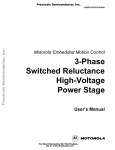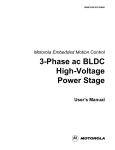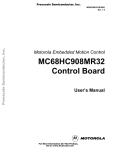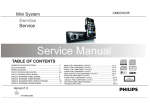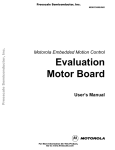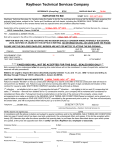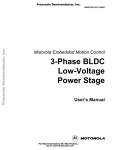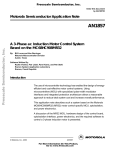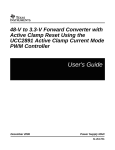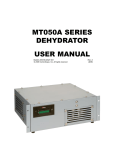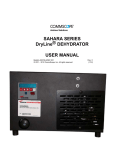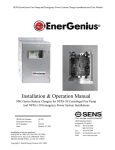Download Optoisolation Board - Freescale Semiconductor
Transcript
Freescale Semiconductor, Inc. Optoisolation Board User’s Manual For More Information On This Product, Go to: www.freescale.com A G R E E M E N T Motorola Embedded Motion Control N O N - D I S C L O S U R E Freescale Semiconductor, Inc... R E Q U I R E D MEMCOBUM/D Freescale Semiconductor, Inc. Optoisolation Board Important Notice to Users Freescale Semiconductor, Inc... While every effort has been made to ensure the accuracy of all information in this document, Motorola assumes no liability to any party for any loss or damage caused by errors or omissions or by statements of any kind in this document, its updates, supplements, or special editions, whether such errors are omissions or statements resulting from negligence, accident, or any other cause. Motorola further assumes no liability arising out of the application or use of any information, product, or system described herein: nor any liability for incidental or consequential damages arising from the use of this document. Motorola disclaims all warranties regarding the information contained herein, whether expressed, implied, or statutory, including implied warranties of merchantability or fitness for a particular purpose. Motorola makes no representation that the interconnection of products in the manner described herein will not infringe on existing or future patent rights, nor do the descriptions contained herein imply the granting or license to make, use or sell equipment constructed in accordance with this description. Trademarks This document includes these trademarks: Motorola and the Motorola logo are registered trademarks of Motorola, Inc. Motorola, Inc., is an Equal Opportunity / Affirmative Action Employer. © Motorola, Inc., 2000; All Rights Reserved User’s Manual 2 Optoisolation Board Optoisolation Board For More Information On This Product, Go to: www.freescale.com MOTOROLA Freescale Semiconductor, Inc. User’s Manual — Optoisolation Board List of Sections Section 1. Introduction and Setup . . . . . . . . . . . . . . . . . . . 9 Freescale Semiconductor, Inc... Section 2. Operational Description . . . . . . . . . . . . . . . . . 15 Section 3. Pin Descriptions . . . . . . . . . . . . . . . . . . . . . . . 17 Section 4. Schematics and Parts List . . . . . . . . . . . . . . . 23 Section 5. Design Considerations . . . . . . . . . . . . . . . . . . 39 Optoisolation Board MOTOROLA User’s Manual List of Sections For More Information On This Product, Go to: www.freescale.com 3 Freescale Semiconductor, Inc. Freescale Semiconductor, Inc... List of Sections User’s Manual 4 Optoisolation Board List of Sections For More Information On This Product, Go to: www.freescale.com MOTOROLA Freescale Semiconductor, Inc. User’s Manual — Optoisolation Board Table of Contents Freescale Semiconductor, Inc... Section 1. Introduction and Setup 1.1 Contents . . . . . . . . . . . . . . . . . . . . . . . . . . . . . . . . . . . . . . . . . . . . . . . . 9 1.2 Optoisolation Introduction . . . . . . . . . . . . . . . . . . . . . . . . . . . . . . . . . . 9 1.3 About this Manual. . . . . . . . . . . . . . . . . . . . . . . . . . . . . . . . . . . . . . . . . 9 1.4 Warnings . . . . . . . . . . . . . . . . . . . . . . . . . . . . . . . . . . . . . . . . . . . . . . . 11 1.5 Setup Guide. . . . . . . . . . . . . . . . . . . . . . . . . . . . . . . . . . . . . . . . . . . . . 12 Section 2. Operational Description 2.1 Contents . . . . . . . . . . . . . . . . . . . . . . . . . . . . . . . . . . . . . . . . . . . . . . . 15 2.2 Introduction. . . . . . . . . . . . . . . . . . . . . . . . . . . . . . . . . . . . . . . . . . . . . 15 2.3 Electrical Characteristics . . . . . . . . . . . . . . . . . . . . . . . . . . . . . . . . . . 16 Section 3. Pin Descriptions 3.1 Contents . . . . . . . . . . . . . . . . . . . . . . . . . . . . . . . . . . . . . . . . . . . . . . . 17 3.2 Introduction. . . . . . . . . . . . . . . . . . . . . . . . . . . . . . . . . . . . . . . . . . . . . 17 3.3 Signal Descriptions . . . . . . . . . . . . . . . . . . . . . . . . . . . . . . . . . . . . . . . 20 Section 4. Schematics and Parts List 4.1 Contents . . . . . . . . . . . . . . . . . . . . . . . . . . . . . . . . . . . . . . . . . . . . . . . 23 4.2 Overview. . . . . . . . . . . . . . . . . . . . . . . . . . . . . . . . . . . . . . . . . . . . . . . 23 4.3 Schematics . . . . . . . . . . . . . . . . . . . . . . . . . . . . . . . . . . . . . . . . . . . . . 24 4.4 Parts List . . . . . . . . . . . . . . . . . . . . . . . . . . . . . . . . . . . . . . . . . . . . . . . 34 Optoisolation Board MOTOROLA User’s Manual Table of Contents For More Information On This Product, Go to: www.freescale.com 5 Freescale Semiconductor, Inc. Table of Contents Section 5. Design Considerations Contents . . . . . . . . . . . . . . . . . . . . . . . . . . . . . . . . . . . . . . . . . . . . . . . 39 5.2 Overview. . . . . . . . . . . . . . . . . . . . . . . . . . . . . . . . . . . . . . . . . . . . . . . 39 5.3 Digital Optoisolation Block . . . . . . . . . . . . . . . . . . . . . . . . . . . . . . . . 40 5.4 Analog Optoisolation Block . . . . . . . . . . . . . . . . . . . . . . . . . . . . . . . . 41 5.5 Serial Link. . . . . . . . . . . . . . . . . . . . . . . . . . . . . . . . . . . . . . . . . . . . . . 42 Freescale Semiconductor, Inc... 5.1 User’s Manual 6 Optoisolation Board Table of Contents For More Information On This Product, Go to: www.freescale.com MOTOROLA Freescale Semiconductor, Inc. User’s Manual — Optoisolation Board List of Figures and Tables Freescale Semiconductor, Inc... Figure Title 1-1 1-2 1-3 Systems Configuration . . . . . . . . . . . . . . . . . . . . . . . . . . . . . . . . . . . . 10 Optoisolation Board . . . . . . . . . . . . . . . . . . . . . . . . . . . . . . . . . . . . . . 10 Optoisolation Board Setup . . . . . . . . . . . . . . . . . . . . . . . . . . . . . . . . . 13 3-1 3-2 40-Pin Output Connector . . . . . . . . . . . . . . . . . . . . . . . . . . . . . . . . . . 18 40-Pin Input Connector. . . . . . . . . . . . . . . . . . . . . . . . . . . . . . . . . . . . 19 4-1 4-2 4-3 4-4 4-5 4-6 4-7 4-8 4-9 Optoisolation Board Overview . . . . . . . . . . . . . . . . . . . . . . . . . . . . . . 25 Control Board to Power Stage Digital Signals (Page 1) . . . . . . . . . . . 26 Control Board to Power Stage Digital Signals (Page 2) . . . . . . . . . . . 27 Power Board to Control Board Digital Signals. . . . . . . . . . . . . . . . . . 28 Analog Current Sense Signals . . . . . . . . . . . . . . . . . . . . . . . . . . . . . . 29 Analog Temperature and dc Bus Sense Signals . . . . . . . . . . . . . . . . . 30 Analog Back EMF Signals . . . . . . . . . . . . . . . . . . . . . . . . . . . . . . . . . 31 Identification Block . . . . . . . . . . . . . . . . . . . . . . . . . . . . . . . . . . . . . . 32 dc/dc Converter. . . . . . . . . . . . . . . . . . . . . . . . . . . . . . . . . . . . . . . . . . 33 5-1 5-2 5-3 Simplified Digital Isolation Block . . . . . . . . . . . . . . . . . . . . . . . . . . . 40 Simplified Analog Isolation Block . . . . . . . . . . . . . . . . . . . . . . . . . . . 41 Bidirectional Serial Link. . . . . . . . . . . . . . . . . . . . . . . . . . . . . . . . . . . 43 Table Title Page 2-1 Electrical Characteristics . . . . . . . . . . . . . . . . . . . . . . . . . . . . . . . . . . 16 3-1 Signal Descriptions . . . . . . . . . . . . . . . . . . . . . . . . . . . . . . . . . . . . . . . 20 4-1 Parts List . . . . . . . . . . . . . . . . . . . . . . . . . . . . . . . . . . . . . . . . . . . . . . . 34 Optoisolation Board MOTOROLA Page User’s Manual List of Figures and Tables For More Information On This Product, Go to: www.freescale.com 7 Freescale Semiconductor, Inc. Freescale Semiconductor, Inc... List of Figures and Tables User’s Manual 8 Optoisolation Board List of Figures and Tables For More Information On This Product, Go to: www.freescale.com MOTOROLA Freescale Semiconductor, Inc. User’s Manual — Optoisolation Board Section 1. Introduction and Setup Freescale Semiconductor, Inc... 1.1 Contents 1.2 Optoisolation Introduction . . . . . . . . . . . . . . . . . . . . . . . . . . . . . . . . . . 9 1.3 About this Manual. . . . . . . . . . . . . . . . . . . . . . . . . . . . . . . . . . . . . . . . . 9 1.4 Warnings . . . . . . . . . . . . . . . . . . . . . . . . . . . . . . . . . . . . . . . . . . . . . . . 11 1.5 Setup Guide. . . . . . . . . . . . . . . . . . . . . . . . . . . . . . . . . . . . . . . . . . . . . 12 1.2 Optoisolation Introduction Motorola’s embedded motion control series optoisolation board is an optoisolator that is an integral part of a development tool set for motor control. It is supplied in kit number ECOPT, along with a 40-pin ribbon cable and mounting hardware. The optoisolation board’s purpose is to provide galvanic isolation between a control board and a high-voltage power stage. It fits into the systems’ configurations that are shown in Figure 1-1. A photograph of the board appears in Figure 1-2. 1.3 About this Manual Key items can be found in the following locations in this manual: • Setup instructions are found in 1.5 Setup Guide. • Schematics are found in 4.3 Schematics. • Pin assignments are shown in Figure 3-1. 40-Pin Output Connector and Figure 3-2. 40-Pin Input Connector, and a pin-by-pin description is contained in 3.3 Signal Descriptions. • For those interested in the reference design aspects of the board’s circuitry, a description is provided in Section 5. Design Considerations. Optoisolation Board MOTOROLA User’s Manual Introduction and Setup For More Information On This Product, Go to: www.freescale.com 9 Freescale Semiconductor, Inc. Introduction and Setup WORKSTATION Freescale Semiconductor, Inc... OPTOISOLATION BOARD DSP EVM BOARD CONTROL BOARD EMULATOR WORKSTATION HIGH-VOLTAGE POWER STAGE OPTOISOLATION BOARD HIGH-VOLTAGE POWER STAGE MOTOR MOTOR OPTIONAL FEEDBACK OPTIONAL FEEDBACK a) MICROCONTROLLER b) 56800 DSP Figure 1-1. Systems’ Configurations Figure 1-2. Optoisolation Board User’s Manual 10 Optoisolation Board Introduction and Setup For More Information On This Product, Go to: www.freescale.com MOTOROLA Freescale Semiconductor, Inc. Introduction and Setup Warnings 1.4 Warnings This development tool set operates in an environment that includes dangerous voltages and rotating machinery. To facilitate safe operation, input power for the high-voltage power stage should come from a current-limited dc laboratory power supply, unless power factor correction is specifically being investigated. Freescale Semiconductor, Inc... When operating from an ac line, power stage grounds and oscilloscope grounds are at different potentials, unless the oscilloscope is floating. Note that probe grounds and, therefore, the case of a floated oscilloscope are subjected to dangerous voltages. The user should be aware that: • Before moving scope probes, making connections, etc., it is generally advisable to power down the high-voltage supply. • When high voltage is applied, using only one hand for operating the test setup minimizes the possibility of electrical shock. • Operation in lab setups that have grounded tables and/or chairs should be avoided. • Wearing safety glasses, avoiding ties and jewelry, using shields, and operation by personnel trained in high-voltage lab techniques are also advisable. Optoisolation Board MOTOROLA User’s Manual Introduction and Setup For More Information On This Product, Go to: www.freescale.com 11 Freescale Semiconductor, Inc. Introduction and Setup 1.5 Setup Guide Setup and connections for the optoisolation board are straightforward. The optoisolation board connects to a Motorola embedded motion control series high-voltage power stage via a 40-pin ribbon cable with a Motorola embedded motion control series control board to form a mother/daughter board arrangement. Figure 1-3 depicts a completed setup. Follow these steps to set up the board: Freescale Semiconductor, Inc... 1. Mount four standoffs to the optoisolation board at the locations indicated in Figure 1-3. Standoffs, screws, and washers are included in the ECOPT kit. This step and step 3 are optional when making connections with DSP control boards such as the DSP56F805EVM. The DSP boards may be placed flat on a bench, next to the optoisolation board. 2. Plug one end of the 40-pin ribbon cable that is supplied with Motorola embedded motion control series control boards into input connector J2, labeled “control board.” 3. Mount the control board on top of the standoffs with screws and washers from the ECOPT kit. This step is optional with DSP control boards. 4. Plug the free end of the cable connected to input connector J2 into the control board’s 40-pin connector. 5. Plug one end of the ECOPT kit’s 40-pin ribbon cable into output connector J1, labeled “power stage.” The other end of this cable goes to the power stage’s 40-pin input connector. 6. Connect a 12-Vdc power supply either to connector JP1, labeled “Ext. Power 12V DC,” or power jack J3. Either one, but not both, may be used. These connectors are located immediately above 40-pin connector J2 on the right side of the optoisolation board. The 12-volt power supply should be rated for at least 1 amp. 7. Apply power first to the optoisolation board, and then to the power stage. Note that the optoisolation board powers the control board and that the optoisolation board is not fully powered until power is applied to the power stage. User’s Manual 12 Optoisolation Board Introduction and Setup For More Information On This Product, Go to: www.freescale.com MOTOROLA Freescale Semiconductor, Inc. Introduction and Setup Setup Guide MOTOR STANDOFFS 40-PIN RIBBON CABLE +12 Vdc CONTROLLER Freescale Semiconductor, Inc... POWER STAGE 40-PIN RIBBON CABLE OPTOISOLATOR J1 J2 STANDOFFS HIGH-VOLTAGE MOTOR SUPPLY Figure 1-3. Optoisolation Board Setup Optoisolation Board MOTOROLA User’s Manual Introduction and Setup For More Information On This Product, Go to: www.freescale.com 13 Freescale Semiconductor, Inc. Freescale Semiconductor, Inc... Introduction and Setup User’s Manual 14 Optoisolation Board Introduction and Setup For More Information On This Product, Go to: www.freescale.com MOTOROLA Freescale Semiconductor, Inc. User’s Manual — Optoisolation Board Section 2. Operational Description Freescale Semiconductor, Inc... 2.1 Contents 2.2 Introduction. . . . . . . . . . . . . . . . . . . . . . . . . . . . . . . . . . . . . . . . . . . . . 15 2.3 Electrical Characteristics . . . . . . . . . . . . . . . . . . . . . . . . . . . . . . . . . . 16 2.2 Introduction Motorola’s embedded motion control series optoisolation board links signals from a controller to a high-voltage power stage. The board isolates the controller, and peripherals that may be attached to the controller, from dangerous voltages that are present on the power stage. The optoisolation board’s galvanic isolation barrier also isolates control signals from high noise in the power stage and provides a noise-robust systems architecture. Signal translation is virtually one-for-one. Gate drive signals are passed from controller to power stage via high-speed, high dv/dt, digital optocouplers. Analog feedback signals are passed back through HCNR201 high-linearity analog optocouplers. Delay times are typically 250 ns for digital signals, and 2 µs for analog signals. Grounds are separated by the optocouplers’ galvanic isolation barrier. Both input and output connections are made via 40-pin ribbon cable connectors. The pin assignments for both connectors are the same. For example, signal PWM_AT appears on pin 1 of the input connector and also on pin 1 of the output connector. In addition to the usual motor control signals, an MC68HC705JJ7CDW serves as a serial link, which allows controller software to identify the power board. Power requirements for controller side circuitry are met with a single external 12-Vdc power supply. Power for power stage side circuitry is supplied from the power stage through the 40-pin output connector. Optoisolation Board MOTOROLA User’s Manual Operational Description For More Information On This Product, Go to: www.freescale.com 15 Freescale Semiconductor, Inc. Operational Description A summary of the information needed to use Motorola’s embedded motion control series optoisolation board is presented below. For design information, see Section 5. Design Considerations. 2.3 Electrical Characteristics Freescale Semiconductor, Inc... The electrical characteristics in Table 2-1 apply to operation at 25°C, and a 12-Vdc power supply voltage. Table 2-1. Electrical Characteristics Characteristic Symbol Min Typ Max Units Notes Power Supply Voltage Vdc 10 12 30 V Quiescent Current ICC 70(1) 200(2) 500(3) mA dc/dc converter Min Logic 1 Input Voltage VIH 2.0 — — V HCT logic Max Logic 0 Input Voltage VIL — — 0.8 V HCT logic Analog Input Range VIn 0 — 3.3 V Input Resistance RIn — 10 — kΩ Analog Output Range VOut 0 — 3.3 V Digital Delay Time tDDLY — 0.25 — µs Analog Delay Time tADLY — 2 — µs 1. Power supply powers optoisolation board only. 2. Current consumption of optoisolation board plus DSP EMV board (powered from this power supply) 3. Maximum current handled by dc/dc converters User’s Manual 16 Optoisolation Board Operational Description For More Information On This Product, Go to: www.freescale.com MOTOROLA Freescale Semiconductor, Inc. User’s Manual — Optoisolation Board Section 3. Pin Descriptions Freescale Semiconductor, Inc... 3.1 Contents 3.2 Introduction. . . . . . . . . . . . . . . . . . . . . . . . . . . . . . . . . . . . . . . . . . . . . 17 3.3 Signal Descriptions . . . . . . . . . . . . . . . . . . . . . . . . . . . . . . . . . . . . . . . 20 3.2 Introduction Inputs and outputs are located on four connectors. They are listed as follows. Location descriptions assume that the board is oriented such that its title is read from left to right. • J2 — Signal inputs are grouped together on 40-pin ribbon cable connector J2, located on the right side of the board. • J1 — Signal outputs are provided on 40-pin ribbon cable connector, J1, located on the left. • JP1 and J3 — Two connectors, labeled JP1 and J3, are provided for the 12-volt power supply. JP1 and J3 are located immediately above input connector J2. Power is supplied to one or the other, but not both. Pin assignments for the input and output connectors are shown in Figure 3-1 and Figure 3-2. In these figures, a schematic representation appears on the left, and a physical layout of the connector appears on the right. The physical view assumes that the board is oriented such that its title is read from left to right. Signal descriptions are provided in Table 3-1. Note that each signal has the same pin assignment on both connectors. Power supply and ground connections go to different power supplies, due to the isolation barrier. However, pin locations for similar power supply voltages remain the same. For example, +15 volts on the input connector and +15 volts on the output connector come from physically different power supplies, but occupy pin 19 on both connectors. Optoisolation Board MOTOROLA User’s Manual Pin Descriptions For More Information On This Product, Go to: www.freescale.com 17 Freescale Semiconductor, Inc. Pin Descriptions J1 Freescale Semiconductor, Inc... BEMF_sense_C BEMF_sense_B BEMF_sense_A Shielding Zero_cross_C Zero_cross_B Zero_cross_A PFC_z_c PFC_inhibit PFC_PWM Serial_Con Brake control Shielding Aux_DIG_IO Temp_sense I_sense_C I_sense_B I_sense_A I_sense_DCB V_sense_DCB –15V_A_PS +15V_A_PS GNDA_PS GNDA_PS +3.3V_A_PS +5V_D_PS +5V_D_PS GND_PS GND_PS PWM_PS Shielding PWM_CT Shielding PWM_BB Shielding PWM_BT Shielding PWM_AB Shielding PWM_AT 40 39 38 37 36 35 34 33 32 31 30 29 28 27 26 25 24 23 22 21 20 19 18 17 16 15 14 13 12 11 10 9 8 7 6 5 4 3 2 1 PWM_AT PWM_AB PWM_BT PWM_BB PWM_CT PWM_CB GND_PS +5V_D GNDA_PS +15_A_PS V_sense_DCB I_sense_A I_sense_C Aux_DIG_IO Brake control PFC_PWM PFC_z_c Zero_cross_B Shielding BEMF_sense_B 1 3 5 7 9 11 13 15 17 19 21 23 25 27 29 31 33 35 37 39 2 4 6 8 10 12 14 16 18 20 22 24 26 28 30 32 34 36 38 40 Shielding Shielding Shielding Shielding Shielding GND_PS +5V_D_PS +3.3V_A_PS GNDA_PS –15V_A_PS I_sense_DCB I_sense_B Temp_sense Shielding Serial_Con PFC_inhibit Zero_cross_A Zero_cross_C BEMF_sense_A BEMF_sense_C PHYSICAL VIEW Notes: _PS suffix = power stage _CB suffix = control board For more information, see 4.2 Overview. CON/40 SCHEMATIC VIEW Figure 3-1. 40-Pin Output Connector User’s Manual 18 Optoisolation Board Pin Descriptions For More Information On This Product, Go to: www.freescale.com MOTOROLA Freescale Semiconductor, Inc. Pin Descriptions Introduction J2 Freescale Semiconductor, Inc... 40 39 38 37 36 35 34 33 32 31 30 29 28 27 26 25 24 23 22 21 20 19 18 17 16 15 14 13 12 11 10 9 8 7 6 5 4 3 2 1 BEMF_sense_C BEMF_sense_B BEMF_sense_A Shielding Zero_cross_C Zero_cross_B Zero_cross_A PFC_z_c PFC_inhibit PFC_PWM Serial_Con Brake control Shielding Aux_DIG_IO Temp_sense I_sense_C I_sense_B I_sense_A I_sense_DCB V_sense_DCB –15V_A_CB +15V_A_CB GNDA_CB GNDA_CB +3.3V_A_CB +5V_D_CB +5V_D_CB GND_CB GND_CB PWM_CB Shielding PWM_CT Shielding PWM_BB Shielding PWM_BT Shielding PWM_AB Shielding PWM_AT PWM_AT PWM_AB PWM_BT PWM_BB PWM_CT PWM_CB GND_CB +5V_D_CB GNDA_CB +15_A_CB V_sense_DCB I_sense_A I_sense_C Aux_DIG_IO Brake control PFC_PWM PFC_z_c Zero_cross_B Shielding BEMF_sense_B 1 3 5 7 9 11 13 15 17 19 21 23 25 27 29 31 33 35 37 39 2 4 6 8 10 12 14 16 18 20 22 24 26 28 30 32 34 36 38 40 Shielding Shielding Shielding Shielding Shielding GND_CB +5V_D_CB +3.3V_A_CB GNDA_CB –15V_A_CB I_sense_DCB I_sense_B Temp_sense Shielding Serial_Con PFC_inhibit Zero_cross_A Zero_cross_C BEMF_sense_A BEMF_sense_C PHYSICAL VIEW Notes: _PS suffix = power stage _CB suffix = control board For more information, see 4.2 Overview. CON/40 SCHEMATIC VIEW Figure 3-2. 40-Pin Input Connector Optoisolation Board MOTOROLA User’s Manual Pin Descriptions For More Information On This Product, Go to: www.freescale.com 19 Freescale Semiconductor, Inc. Pin Descriptions 3.3 Signal Descriptions Table 3-1. Signal Descriptions (Sheet 1 of 3) Signal Name Description 1 PWM_AT PWM_AT is the gate drive signal for the top half-bridge of phase A. A logic high at input connector J2 produces a logic high at output connector J1, which turns the power stage’s phase A top switch on. 2 Shielding Pin 2 is connected to an unused wire that helps prevent cross-talk between adjacent signals. 3 PWM_AB PWM_AB is the gate drive signal for the bottom half-bridge of phase A. A logic high at input connector J2 produces a logic high at output connector J1, which turns the power stage’s phase A bottom switch on. 4 Shielding Pin 4 is connected to an unused wire that helps prevent cross-talk between adjacent signals. 5 PWM_BT PWM_BT is the gate drive signal for the top half-bridge of phase B. A logic high at input connector J2 produces a logic high at output connector J1, which turns the power stage’s phase B top switch on. 6 Shielding Pin 6 is connected to an unused wire that helps prevent cross-talk between adjacent signals. 7 PWM_BB PWM_BB is the gate drive signal for the bottom half-bridge of phase B. A logic high at input connector J2 produces a logic high at output connector J1, which turns the power stage’s phase B bottom switch on. 8 Shielding Pin 8 is connected to an unused wire that helps prevent cross-talk between adjacent signals. 9 PWM_CT PWM_CT is the gate drive signal for the top half-bridge of phase C. A logic high at input connector J2 produces a logic high at output connector J1, which turns the power stage’s phase C top switch on. 10 Shielding Pin 10 is connected to an unused wire that helps prevent cross-talk between adjacent signals. 11 PWM_CB PWM_CB is the gate drive signal for the bottom half-bridge of phase C. A logic high at input connector J2 produces a logic high at output connector J1, which turns the power stage’s phase C bottom switch on. 12 GND_CB and GND_PS Digital power supply ground 13 GND_CB and GND_PS Digital power supply ground, redundant connection Freescale Semiconductor, Inc... Pin No. User’s Manual 20 Optoisolation Board Pin Descriptions For More Information On This Product, Go to: www.freescale.com MOTOROLA Freescale Semiconductor, Inc. Pin Descriptions Signal Descriptions Freescale Semiconductor, Inc... Table 3-1. Signal Descriptions (Sheet 2 of 3) Pin No. Signal Name 14 +5V_D_CB and +5V_D_PS Digital +5-volt power supply. +5V_D_PS originates on the power stage board 15 +5V_D_CB and +5V_D_PS Digital +5-volt power supply, redundant connection 16 +3.3V_A_CB and +3.3V_A_PS 17 GNDA_CB and GNDA_PS Analog power supply ground 18 GNDA_CB and GNDA_PS Analog power supply ground, redundant connection 19 +15V_A_CB and +15V_A_PS 20 -15V_A_CB and –15V_A_PS 21 V_sense_DCB V_sense_DCB is an analog sense signal that measures the power stage’s dc bus voltage. 22 I_sense_DCB I_sense_DCB is an analog sense signal that measures the power stage’s dc bus current. 23 I_sense_A I_sense_A is an analog sense signal that measures current in phase A. 24 I_sense_B I_sense_B is an analog sense signal that measures current in phase B. 25 I_sense_C I_sense_C is an analog sense signal that measures current in phase C. 26 Temp_sense Temp_sense is an analog sense signal that measures power module temperature. 27 AUX_DIG_IO This is an unused spare digital link that can be configured to send a signal in either direction. 28 Shielding Pin 28 is connected to an unused wire that helps prevent cross-talk between adjacent signals. 29 Brake_control Brake_control is the gate drive signal for the power stage’s brake transistor. 30 Serial_Con Serial_Con is a bidirectional digital serial interface that is used to identify the power stage to the controller. This information is then used by the controller’s software to scale analog feedback signals. 31 PFC_PWM PFC_PWM is a digital signal that controls the power factor correction circuit’s switch. 32 PFC_inhibit PFC_inhibit is a digital output that is used to enable or disable the power factor correction circuit. Description Analog +3.3-volt power supply. +3.3V_A_PS originates on the power stage. Analog +15-volt power supply. +15V_A_PS originates on the power stage. Analog -15 V power supply. –15V_A_PS originates on the power stage. Optoisolation Board MOTOROLA User’s Manual Pin Descriptions For More Information On This Product, Go to: www.freescale.com 21 Freescale Semiconductor, Inc. Pin Descriptions Table 3-1. Signal Descriptions (Sheet 3 of 3) Signal Name 33 PFC_z_c PFC_z_c is a digital signal. Its edges represent power line voltage zero crossing events. 34 Zero_cross_A Zero_cross_A is a digital signal that is used for sensing phase A back-EMF zero crossing events. 35 Zero_cross_B Zero_cross_B is a digital signal that is used for sensing phase B back-EMF zero crossing events. 36 Zero_cross_C Zero_cross_C is a digital signal that is used for sensing phase C back-EMF zero crossing events. 37 Shielding Pin 37 is connected to an unused wire that helps prevent cross-talk between adjacent signals. 38 BEMF_sense_A BEMF_sense_A is an analog sense signal that measures phase A back EMF. 39 BEMF_sense_B BEMF_sense_B is an analog sense signal that measures phase B back EMF. 40 BEMF_sense_C BEMF_sense_A is an analog sense signal that measures phase C back EMF. Freescale Semiconductor, Inc... Pin No. Description User’s Manual 22 Optoisolation Board Pin Descriptions For More Information On This Product, Go to: www.freescale.com MOTOROLA Freescale Semiconductor, Inc. User’s Manual — Optoisolation Board Section 4. Schematics and Parts List Freescale Semiconductor, Inc... 4.1 Contents 4.2 Overview. . . . . . . . . . . . . . . . . . . . . . . . . . . . . . . . . . . . . . . . . . . . . . . 23 4.3 Schematics . . . . . . . . . . . . . . . . . . . . . . . . . . . . . . . . . . . . . . . . . . . . . 24 4.4 Parts List . . . . . . . . . . . . . . . . . . . . . . . . . . . . . . . . . . . . . . . . . . . . . . . 34 4.2 Overview A set of schematics for the optoisolation board appears in Figure 4-1 through Figure 4-9. An overview of the whole board is shown in Figure 4-1. Digital isolation blocks appear in Figure 4-2 through Figure 4-4. Analog isolation blocks are shown in Figure 4-5 through Figure 4-7. The serial link appears in Figure 4-8, and an on-board power supply that converts +12 volts into +5 V, +3.3 V, +15 V and –15 V is shown in Figure 4-9. Unless otherwise specified, resistor values are in ohms, resistors are specified as 1/8 watt ± 5%, and interrupted lines coded with the same letters are electrically connected. The high-level schematic in Figure 4-1 identifies individual signals with the same designation upon both entering and leaving the board. For example, temperature sense signal “Temp_sense” comes into the board on pin 26 of connector J2, leaves on pin 26 of J1, and is labeled “Temp_sense” in both places. Since the power supplies connected to J1 and J2 are physically different, power supply and ground designations include “_PS” or “_CB.” “_PS” refers to the power stage side of the isolation barrier. Similarly, “_CB” refers to the control board side of the isolation barrier. For example, the +15-volt analog supply is labeled “+15V_A_CB” on pin 19 of input connector J2. Similarly, the +15-volt connection on pin 19 of output connector J1 is labeled “+15V_A_PS.” Optoisolation Board MOTOROLA User’s Manual Schematics and Parts List For More Information On This Product, Go to: www.freescale.com 23 Freescale Semiconductor, Inc. Schematics and Parts List Freescale Semiconductor, Inc... In the detail-level schematics, signals also get “_CB” or “_PS” adders to indicate which connector they are coming from. For example, the signal identified as “Temp_sense” in high-level schematic Figure 4-1 appears on the left-hand side of Figure 4-6 as “Temp_sense_PS.” The “_PS” adder indicates that the signal “Temp_sense” at the input to U500A comes from output connector J1. Similarly, “Temp_sense_CB” on the right hand side of Figure 4-6 indicates that a connection is made to input connector J2. 4.3 Schematics The schematics for the optoisolation board appear on the following pages. User’s Manual 24 Optoisolation Board Schematics and Parts List For More Information On This Product, Go to: www.freescale.com MOTOROLA Connect to PS (Power Stage) P_3.3V_A_PS MP4 GND_PS GND_PS P_15V_A_PS N_15V_A_PS GNDA_PS R1 MP7 GNDA_CB +15V_A_CB MP8 PWM_CB_CB PWM_CT_CB PWM_BB_CB PWM_BT_CB PWM_AB_CB PWM_AT_CB +5V_D_CB GND_CB GNDA_CB +3.3V_A_CB Temp_sense_CB I_sense_DCB_CB V_sense_DCB_CB GNDA_CB +3.3V_A_CB I_sense_C_CB I_sense_B_CB I_sense_A_CB +5V_D_CB GND_CB PFC_inhibit_CB PFC_PWM_CB Breake_control_CB Aux_IO_CB Serial_con_CB +5V_D_CB GND_CB +5V_D_CB GND_CB Zero_cross_C_CB Zero_cross_B_CB Zero_cross_A_CB PFC_Z_C_CB +3.3V_A_CB GNDA_CB BEMF_sense_A_CB BEMF_sense_B_CB BEMF_sense_C_CB Opto Isolation Barrier BEMF_sense_A_PS BEMF_sense_B_PS BEMF_sense_C_PS +15V_A_PS -15V_A_PS GNDA_PS Analog_BEMF Zero_cross_C_PS Zero_cross_B_PS Zero_cross_A_PS PFC_Z_C_PS +5V_D_PS GND_PS Digital_PS_to_CB +5V_D_PS GND_PS Serial_con_PS Identif PFC_inhibit_PS PFC_PWM_PS Breake_control_PS Aux_IO_PS +5V_D_PS GND_PS Digital_CB_to_PS I_sense_C_PS I_sense_B_PS I_sense_A_PS +15V_A_PS -15V_A_PS GNDA_PS Analog_I_sense Temp_sense_PS I_sense_DCB_PS V_sense_DCB_PS +15V_A_PS -15V_A_PS GNDA_PS D1 LED GND_PS Digital_PWM PWM_CB_PS PWM_CT_PS PWM_BB_PS PWM_BT_PS PWM_AB_PS PWM_AT_PS +5V_D_PS GND_PS Analog_Temp_DCB 470 P_5V_D_PS MP5 MP6 GND_PS +5V_D_PS MP9 -15V_A_CB GND_CB MP11 P_5V_D P_15V_A N_15V_A GND P_3.3V_A MP10 +3.3V_A_CB MP12 +5V_D_CB J2 40 39 38 37 36 35 34 33 32 31 30 29 28 27 26 25 24 23 22 21 20 19 18 17 16 15 14 13 12 11 10 9 8 7 6 5 4 3 2 1 CON/40 -Ext_V +Ext_V BreadBoard -V 1 +V 3 -V J3 Power Jack 2 12-15V DC JP1 8-12V AC CON/2screws BEMF_sense_C BEMF_sense_B BEMF_sense_A Shielding Zero_cross_C Zero_cross_B Zero_cross_A PFC_z_c PFC_inhibit PFC_PWM Serial_Con Breake_control Shielding Aux_DIG_IO_CB Temp_sense I_sense_C I_sense_B I_sense_A I_sense_DCB V_sense_DCB -15V_A_CB +15V_A_CB GNDA_CB GNDA_CB +3.3V_A_CB +5V_D_CB +5V_D_CB GND_CB GND_CB PWM_CB Sheilding PWM_CT Sheilding PWM_BB Sheilding PWM_BT Sheilding PWM_AB Sheilding PWM_AT Connect to CB (Control Board) +5V_D_CB +15V_A_CB -15V_A_CB GND_CB +3.3V_A_CB DC/DC_converter For More Information On This Product, Go to: www.freescale.com J1 40 39 38 37 36 35 34 33 32 31 30 29 28 27 26 25 24 23 22 21 20 19 18 17 16 15 14 13 12 11 10 9 8 7 6 5 4 3 2 1 CON/40 MP2 MP3 -15V_A_PS +3.3V_A_PS 1 2 BEMF_sense_C BEMF_sense_B BEMF_sense_A Shielding Zero_cross_C Zero_cross_B Zero_cross_A PFC_z_c PFC_inhibit PFC_PWM Serial_Con Breake_control Shielding Aux_DIG_IO_PS Temp_sense I_sense_C I_sense_B I_sense_A I_sense_DCB V_sense_DCB -15V_A_PS +15V_A_PS GNDA_PS GNDA_PS +3.3V_A_PS +5V_D_PS +5V_D_PS GND_PS GND_PS PWM_CB Sheilding PWM_CT Sheilding PWM_BB Sheilding PWM_BT Sheilding PWM_AB Sheilding PWM_AT BreadBoard MP1 GNDA_PS +15V_A_PS Figure 4-1. Optoisolator Board Overview Freescale Semiconductor, Inc... Freescale Semiconductor, Inc. PWM_AT_PS PWM_AB_PS PWM_BT_PS PWM_BB_PS PWM_CT_PS PWM_CB_PS +5V_D_PS GND_PS 4 2 6 12 10 8 3 U600B MC74HCT14AD +5V_D_PS 1 U600A MC74HCT14AD GND_PS 5 U600C MC74HCT14AD U600F MC74HCT14AD 13 11 U600E MC74HCT14AD U600D MC74HCT14AD 9 +5V_D_PS + R600 1.8k R603 1.8k R606 1.8k R609 1.8k R612 1.8k R615 1.8k +5V_D_PS 8 6 5 GND_PS +5V_D_PS 8 6 5 8 GND_PS +5V_D_PS 6 5 GND_PS +5V_D_PS 8 6 5 GND_PS +5V_D_PS 8 6 5 GND_PS +5V_D_PS 8 6 5 GND_PS ISO600 Vcc Vo Gnd 3 Anode 2 Cathode Cathode 3 Anode 2 HCPL-J454#300 ISO601 Vcc Vo Gnd Cathode 3 Anode 2 HCPL-J454#300 ISO602 Vcc Vo Gnd Cathode 3 Anode 2 HCPL-J454#300 ISO603 Vcc Vo Gnd Cathode 3 Anode 2 HCPL-J454#300 ISO604 Vcc Vo Gnd Cathode 3 Anode 2 HCPL-J454#300 ISO605 Vcc Vo Gnd HCPL-J454#300 +5V_D_CB R601 330 +5V_D_CB R604 330 +5V_D_CB R607 330 +5V_D_CB R610 330 +5V_D_CB R613 330 +5V_D_CB R616 330 3 6 8 3 6 8 2 10 2 10 GND_CB R617 10k U602C MC74HCT00AD 9 5 U602B MC74HCT00AD 4 GND_CB U602A MC74HCT00AD 1 +5V_D_CB U601C MC74HCT00AD 9 5 U601B MC74HCT00AD 4 GND_CB U601A MC74HCT00AD 1 +5V_D_CB 14 R602 10k GND_CB R605 10k GND_CB R608 10k GND_CB R611 10k GND_CB R614 10k GND_CB PWM_AT_CB PWM_AB_CB PWM_BT_CB PWM_BB_CB PWM_CT_CB PWM_CB_CB Figure 4-2. Control Board to Power Stage Digital Signals (Page 1) C605 Cap's placed close to IC's 10uF/6.3V C600 10nF GND_PS +5V_D_CB C601 10nF C602 10nF C603 10nF C604 100nF +5V_D_CB GND_CB Cap's placed close to IC's GND_CB For More Information On This Product, Go to: www.freescale.com 14 7 7 14 7 Freescale Semiconductor, Inc... Freescale Semiconductor, Inc. +5V_D_PS GND_PS +5V_D_PS GND_PS C300 10nF PFC_inhibit_PS PFC_PWM_PS + C301 10uF/6.3V 2 4 6 10 Control Board to Power Stage Signal Direction Jumper * JP301 SM/Jumper 1 12 U300F MC74HCT14AD 11 U300E MC74HCT14AD 5 U300C MC74HCT14AD 3 U300B MC74HCT14AD GND_PS U300A MC74HCT14AD +5V_D_PS 14 7 * Either JP301 or JP303 can be shorted Breake_control_PS Aux_IO_PS 13 R300 1.8k R303 1.8k R306 1.8k R310 1.8k 3 2 Gnd Vcc Vo ISO300 +5V_D_PS 8 6 5 Anode Cathode Cathode Anode GND_PS HCPL-J454#300 Gnd Vcc Vo ISO301 +5V_D_PS 8 6 5 Cathode Anode GND_PS HCPL-J454#300 Gnd Vcc Vo ISO302 +5V_D_PS 8 6 5 Vcc Vo 6 +5V_D_CB 2 3 +5V_D_CB 2 3 2 3 2 3 R301 330 R304 330 11 10 3 6 8 MC74HCT14AD U201E R307 330 11 330 R309 +5V_D_CB +5V_D_CB 1.8k R312 Cathode Anode GND_PS HCPL-J454#300 8 Gnd Vcc Vo +5V_D_PS ISO303 6 5 GND_PS HCPL-J454#300 Gnd GND_CB 5 8 +5V_D_CB HCPL-J454#300 Cathode Anode +5V_D_PS ISO304 R311 330 +5V_D_CB 2 U301A MC74HCT00AD 1 GND_CB U301B MC74HCT00AD 4 5 U301C MC74HCT00AD 9 10 U301D MC74HCT00AD 12 13 + C302 10uF/6.3V R302 10k GND_CB R305 10k GND_CB R308 10k GND_CB Figure 4-3. Control Board to Power Stage Digital Signals (Page 2) C303 10nF PFC_inhibit_CB PFC_PWM_CB Breake_control_CB JP303 SM/Jumper +5V_D_CB GND_CB +5V_D_CB GND_CB Aux_IO_CB Power Stage to Control Board Signal Direction Jumper * For More Information On This Product, Go to: www.freescale.com 14 7 Freescale Semiconductor, Inc... Freescale Semiconductor, Inc. +5V_D_PS GND_PS Zero_cross_A_PS Zero_cross_B_PS Zero_cross_C_PS PFC_Z_C_PS C200 10nF +5V_D_PS GND_PS C202 100nF 1 2 4 5 9 10 12 13 GND_PS U200B MC74HCT00AD U200C MC74HCT00AD U200D MC74HCT00AD 3 11 8 6 U200A MC74HCT00AD +5V_D_PS 14 7 R200 330 R203 330 R205 330 R207 330 +5V_D_PS 2 3 +5V_D_PS 2 3 +5V_D_PS 2 3 Anode ISO200 Cathode HCPL-J454#300 ISO201 Anode Cathode HCPL-J454#300 Anode ISO202 Cathode Anode ISO203 HCPL-J454#300 2 +5V_D_PS 3 Cathode HCPL-J454#300 Vcc Vo 5 6 8 Gnd Vcc Vo 6 8 Gnd 5 Vcc Vo 5 6 8 Gnd 6 8 Vo Vcc Gnd 5 1.8k +5V_D_CB R201 GND_CB 1.8k +5V_D_CB R202 GND_CB 1.8k +5V_D_CB R204 GND_CB 1.8k +5V_D_CB R206 GND_CB 1 3 5 9 +5V_D_CB U201A MC74HCT14AD 2 GND_CB C201 10nF +5V_D_CB U201D MC74HCT14AD 8 U201C MC74HCT14AD 6 U201B MC74HCT14AD 4 GND_CB Figure 4-4. Power Board to Control Board Digital Signals Zero_cross_A_CB Zero_cross_B_CB Zero_cross_C_CB PFC_Z_C_CB +5V_D_CB GND_CB For More Information On This Product, Go to: www.freescale.com 14 7 Freescale Semiconductor, Inc... Freescale Semiconductor, Inc. 5 6 + - 10pF + - D400 C400 7 1N4148 10pF 1N4148 U400B MC34072D D401 7 U402B MC34072D 1N4148 R404 100 R408 100 8 7 5 PD2 6 n/c ISO400 1 LED n/c 2 3 PD1 4 HCNR201#300 8 7 7 8 5 PD2 6 n/c ISO401 1 LED n/c 2 3 PD1 4 HCNR201#300 n/c ISO402 1 LED n/c 2 82k(OPTIONAL) R401 C402 6.8pF 6 5 82k(OPTIONAL) R418 100k GNDA_CB R405 6.8pF C404 3 2 GNDA_CB R419 100k GNDA_CB 82k(OPTIONAL) R410 6.8pF C406 - + - R400 C403 5 6 D402 R412 100 6 5 + 1 U400A MC34072D +15V_A_PS + 100k-1% GNDA_PS R409 100k-1% 10pF + 7 U403B MC34072D R420 100k + - - 3 1 C405 5 6 - 5 PD2 6 HCNR201#300 3 PD1 4 GNDA_CB - + R402 +3.3V_A_CB C401 220nF +3.3V_A_CB GNDA_CB I_sense_C_CB I_sense_B_CB I_sense_A_CB GNDA_CB Either the 82k(OPTIONAL) resistor or the 100k-1% resistor is used 47k-SM/Trim_4315 R403 100k-1% U103B MC33502D 7 R406 Either the 82k(OPTIONAL) resistor or the 100k-1% resistor is used 47k-SM/Trim_4315 R407 100k-1% U401A MC33502D 1 +3.3V_A_CB R411 Either the 82k(OPTIONAL) resistor or the 100k-1% resistor is used 47k-SM/Trim_4315 R413 100k-1% U401B MC33502D 7 For More Information On This Product, Go to: www.freescale.com 2 + - U402A MC34072D +15V_A_PS -15V_A_PS 3 2 GNDA_PS R414 100k-1% GNDA_PS + R415 10M R416 10M 1 C411 GNDA_PS - GNDA_PS GNDA_PS + U403A MC34072D +15V_A_PS -15V_A_PS 3 - -15V_A_PS 220nF 2 C409 C410 R417 10M +15V_A_PS 220nF 220nF GNDA_PS C407 C412 220nF 220nF C408 220nF Figure 4-5. Analog Current Sense Signals + I_sense_A_PS I_sense_B_PS I_sense_C_PS +15V_A_PS Cap's placed close to OP's GNDA_PS -15V_A_PS -15V_A_PS 4 8 8 4 8 4 8 4 8 4 8 4 8 4 Freescale Semiconductor, Inc... Freescale Semiconductor, Inc. + - 10pF + - 10pF + - 1N4148 10pF D500 C500 7 1N4148 1N4148 U500B MC34072D D501 7 U501B MC34072D D502 7 U504B MC34072D R504 100 R508 100 R513 100 ISO500 1 LED 2 n/c n/c 8 7 5 PD2 6 HCNR201#300 3 PD1 4 8 7 7 8 5 PD2 6 n/c ISO501 1 LED n/c 2 3 PD1 4 HCNR201#300 n/c ISO502 1 LED n/c 2 10k 7 R518 100k 82k(OPTIONAL) R501 2 6.8pF C503 GNDA_CB 3 82k(OPTIONAL) GNDA_CB R505 6.8pF C505 6 5 82k(OPTIONAL) R519 100k GNDA_CB R510 6.8pF C507 + + - 2 3 GNDA_CB GNDA_CB R520 100k - 5 6 C504 5 6 C506 5 6 + 5 PD2 6 HCNR201#300 3 PD1 4 R521 - + R500 100k-1% GNDA_PS R509 100k-1% GNDA_PS R514 100k-1% GNDA_PS R522 10k 6 5 - C512 GNDA_PS + 1 U500A MC34072D +15V_A_PS + - -15V_A_PS 1 U501A MC34072D +15V_A_PS + - 220nF 1 C509 C513 - 3 2 3 2 + - U504A MC34072D +15V_A_PS -15V_A_PS 3 2 220nF 220nF U503B MC33502D + + R515 10M R516 10M R517 10M C511 -15V_A_PS 220nF R523 10k - GNDA_PS GNDA_PS GNDA_PS +15V_A_PS C508 220nF C510 220nF Cap's placed close to OP's + TEMP_sense_PS I_sense_DCB_PS V_sense_DCB_PS +15V_A_PS GNDA_PS -15V_A_PS -15V_A_PS R502 Cap's placed close to OP's TEMP_sense_CB C501 220nF +3.3V_A_CB C502 220nF +3.3V_A_CB GNDA_CB V_sense_DCB_CB I_sense_DCB_CB GNDA_CB Either the 82k(OPTIONAL) resistor or the 100k-1% resistor is used 47k-SM/Trim_4315 R503 100k-1% U502A MC33502D 1 +3.3V_A_CB R506 Either the 82k(OPTIONAL) resistor or the 100k-1% resistor is used 47k-SM/Trim_4315 R507 100k-1% U502B MC33502D 7 R511 Either the 82k(OPTIONAL) resistor or the 100k-1% resistor is used 47k-SM/Trim_4315 R512 100k-1% U503A MC33502D 1 +3.3V_A_CB Figure 4-6. Analog Temperature and dc Bus Sense Signals For More Information On This Product, Go to: www.freescale.com 4 8 4 8 8 4 8 4 8 4 8 4 8 4 8 4 Freescale Semiconductor, Inc... Freescale Semiconductor, Inc. + - 10pF + - 10pF + D100 1N4148 C100 10pF 7 1N4148 1N4148 U100B MC34072D D101 U101B MC34072D 7 D102 U104B MC34072D 7 R104 100 R109 100 R115 100 n/c ISO100 1 LED n/c 2 8 7 5 PD2 6 HCNR201#300 3 PD1 4 8 7 7 8 5 PD2 6 n/c ISO101 1 LED n/c 2 3 PD1 4 HCNR201#300 ISO102 1 LED n/c n/c R120 100k 82k(OPTIONAL) R101 6.8pF C102 2 GNDA_CB 3 82k(OPTIONAL) GNDA_CB R106 C104 6.8pF 6 5 3 2 GNDA_CB 6.8pF C106 R112 82k(OPTIONAL) R121 100k GNDA_CB R122 100k - - 5 6 C103 5 6 C105 5 6 - 2 5 PD2 6 HCNR201#300 3 PD1 4 GNDA_CB + + R100 100k-1% GNDA_PS R110 100k-1% GNDA_PS - - 1 U100A MC34072D +15V_A_PS + - -15V_A_PS 1 U101A MC34072D +15V_A_PS + - C112 GNDA_PS + + 3 2 3 2 GNDA_PS R116 220nF 1 C110 C113 - - R117 10M R118 10M + - U104A MC34072D +15V_A_PS -15V_A_PS 3 2 220nF 220nF 100k-1% C111 -15V_A_PS 220nF + + BEMF_sense_A_PS GNDA_PS BEMF_sense_B_PS GNDA_PS R119 10M 220nF C108 220nF C107 +15V_A_PS GNDA_PS BEMF_sense_C_PS +15V_A_PS GNDA_PS -15V_A_PS -15V_A_PS Figure 4-7. Analog Back EMF Signals R102 BEMF_sense_A_CB C109 220nF GNDA_CB +3.3V_A_CB GNDA_CB BEMF_sense_C_CB BEMF_sense_B_CB C101 220nF Either the 82k(OPTIONAL) resistor or the 100k-1% resistor is used +3.3V_A_CB 47k-SM/Trim_4315 R103 100k-1% U102A MC33502D 1 +3.3V_A_CB R107 Either the 82k(OPTIONAL) resistor or the 100k-1% resistor is used 47k-SM/Trim_4315 R108 100k-1% U102B MC33502D 7 R113 Either the 82k(OPTIONAL) resistor or the 100k-1% resistor is used 47k-SM/Trim_4315 R114 100k-1% U103A MC33502D 1 +3.3V_A_CB For More Information On This Product, Go to: www.freescale.com 4 8 4 8 8 4 8 4 8 4 8 4 8 4 8 4 Freescale Semiconductor, Inc... Freescale Semiconductor, Inc. R800 1.8k 9 U300D MC74HCT14AD 8 R802 330 2 3 ISO800 Anode Cathode R803 470 GND_CB 1.8k R801 +5V_D_CB 6 8 Vcc Vo 5 2 3 Gnd Cathode Anode HCPL-J454#300 Vcc Vo ISO801 6 Gnd 8 5 HCPL-J454#300 R808 10k GND_CB X1 4MHz GND_CB Serial_con_CB 12 VCC 7 6 5 4 3 2 1 10 9 8 19 +5V_D_CB GND PA3 PA4 PA5 PB0 IRQ RESET OSC2 OSC1 PA2 PA1 PA0 MC68HC705JJ7DW_MOD 13 U201F MC74HCT14AD 18 11 12 13 14 15 16 17 20 PB7 PB6 PB5 PB4/TCMP PB3/TCAP PB2/AN2 PB1/AN1 U801 R804 10k R806 10k R807 10k 10uF/6.3V + C801 R805 10k +5V_D_CB C800 10nF +5V_D_CB GND_CB 7 5 3 1 +5V_D_CB JP800 8 6 4 2 SM/JUMPER4x2 DEFAULT SETTINGS FOR OPTOBOARD: 0 - PB0 = L 1 - PB1 = H 2 - PB2 = L 3 - PB3 = L 4 - PB4 = H 5 - PB5 = H 6 - PB6 = H 7 - PB7 = H +5V_D_CB GND_CB Coding bit # 7 6 5 4 GND_CB For More Information On This Product, Go to: www.freescale.com +5V_D_PS Serial_con_PS GND_PS Figure 4-8. Identification Block Freescale Semiconductor, Inc... Freescale Semiconductor, Inc. D700 MBR0540T1 D701 MBR0540T1 D702 MBR0540T1 D703 MBR0540T1 C700 2.2uF/35V + C702 100nF C707 100nF 1 24 12 13 1 24 +Vin +Vin -Vout -Vout +Vout +Vout U700 -Vin -Vin +V out +V out TEF2011 U701 +V in +V in 0V out 0V out -V out -V out 11 14 10 15 11 14 10 15 2 23 C703 100nF C704 100nF C708 100nF C701 10uF/6.3V + + C705 22uF/16V + C709 22uF/16V + C710 10uF/6.3V 1 3 Vin D705 Vout U702 MC78PC33 CE D704 C711 10uF/6.3V MBR0530T1 5 + LED R700 470 +5V_D_CB +3.3V_A_CB +15V_A_CB GND_CB -15V_A_CB For More Information On This Product, Go to: www.freescale.com +Ext_V -Ext_V C706 2.2uF/35V + 12 13 -V in -V in TEF2022 Figure 4-9. dc/dc Converter Gnd 2 Freescale Semiconductor, Inc... Freescale Semiconductor, Inc. Freescale Semiconductor, Inc. Schematics and Parts List 4.4 Parts List The Optoisolation Board’s parts content is described by the following parts list. Freescale Semiconductor, Inc... Table 4-1. Parts List (Sheet 1 of 4) Qty. Reference Part Value Description Mfg. 9 C100, C103, C105, C400, C403, C405, C500, C504, C506 10 pF Capacitor, ceramic 10 pF Vitramon/ Vishay VJ0805A100DXA_ 23 C101, C107, C108, C109, C110, C111, C112, C113, C401, C407, C408, C409, C410, C411, C412, C501, C502, C508, C509, C510, C511, C512, C513 220 nF Capacitor, ceramic 220 nF/25 V, Z5U, ± 20% Vitramon/ Vishay VJ0805U224MXXA_ 9 C102, C104, C106, C402, C404, C406, C503, C505, C507 6.8 pF Capacitor, ceramic 6.8 pF Vitramon/ Vishay VJ0805A6R8DXA_ 9 C200, C201, C300, C303, C600, C601, C602, C603, C800 10 nF Capacitor, ceramic 10 nF/25 V, Z5U, ± 20% Vitramon/ Vishay VJ0805U103MXXA_ 7 C202, C604, C702, C703, C704, C707, C708 100 nF Capacitor, ceramic 100 nF/25 V, Z5U, ± 20% Vitramon/ Vishay VJ0805U104MXXA_ 7 C301, C302, C605, C701, C710, C711, C801 10 µF/6.3 V Tantalum capacitor 10 µF/6.3 V Commonwealth Sprague 293D106X06R3B2 2 C700, C706 2.2 µF/35 V Tantalum capacitor 2.2 µF/35 V Commonwealth Sprague 293D225X0035C2 2 C705, C709 22 µF/16 V Tantalum capacitor 22 µF/16 V Commonwealth Sprague 293D226X0016D2 2 D704, D1 Green LED Green LED 10 mA Kingbright LED L-934GT 9 D100, D101, D102, D400, D401, D402, D500, D501, D502 1N4148 SMD/1N4148 Fairchild Semiconductor 1N4148LL-34 4 D700, D701, D702, D703 MBR0540T1 Schottky diode ON Semiconductor MBR0540T1 User’s Manual 34 Mfg. Part No. Optoisolation Board Schematics and Parts List For More Information On This Product, Go to: www.freescale.com MOTOROLA Freescale Semiconductor, Inc. Schematics and Parts List Parts List Table 4-1. Parts List (Sheet 2 of 4) Freescale Semiconductor, Inc... Qty. Reference 1 D705 9 ISO100, ISO101, ISO102, ISO400, ISO401, ISO402, ISO500, ISO501, ISO502 17 ISO200, ISO201, ISO202, ISO203, ISO300, ISO301, ISO302, ISO303, ISO304, ISO600, ISO601, ISO602, ISO603, ISO604, ISO605, ISO800, ISO801 1 JP1 2 J2, J1 1 J3 18 R100, R103, R108, R110, R114, R116, R400, R403, R407, R409, R413, R414, R500, R503, R507, R509, R512, R514 9 Part Value Description Mfg. Mfg. Part No. Schottky diode ON Semiconductor MBR0530T1 Linear optoisolator HP HCNR201#300 HCPL-J454#300 Digital optoisolator HP HCPL-J454#300 MBR0530T1 HCNR201#300 CON/2screws 2 screws PCB terminal, 200 mils WAGO 237-132 CON/40 Header 40 pins breakaway conn. Fischer Elektronik GmbH ASLG40G Power jack Power jack type connector 2.1 CUI Stack, Inc. PJ-002A 100 k Resistor 100 kΩ, 1% Dale CRCW0805-1003F R102, R107, R113, R402, R406, R411, R502, R506, R511 47 k SMT trimmer potentiometer Panasonic — 9 R104, R109, R115, R404, R408, R412, R504, R508, R513 100 Resistor 100 Ω, 5% Dale CRCW0805-101J 9 R117, R118, R119, R415, R416, R417, R515, R516, R517 10 M Resistor 10 MΩ, 5% Dale CRCW0805-106J Optoisolation Board MOTOROLA User’s Manual Schematics and Parts List For More Information On This Product, Go to: www.freescale.com 35 Freescale Semiconductor, Inc. Schematics and Parts List Freescale Semiconductor, Inc... Table 4-1. Parts List (Sheet 3 of 4) Qty. Reference Part Value Description Mfg. 9 R120, R121, R122, R418, R419, R420, R518, R519, R520 100 k Resistor 100 kΩ, 5% Dale CRCW0805-104J 16 R200, R203, R205, R207, R301, R304, R307, R309, R311, R601, R604, R607, R610, R613, R616, R802 330 Resistor 330 Ω, 5% Dale CRCW0805-331J 17 R201, R202, R204, R206, R300, R303, R306, R310, R312, R600, R603, R606, R609, R612, R615, R800, R801 1.8 k Resistor 1.8 kΩ, 5% Dale CRCW0805-182J 17 R302, R305, R308, R521, R522, R523, R602, R605, R608, R611, R614, R617, R804, R805, R806, R807, R808 10 k Resistor 10 kΩ, 5% Dale CRCW0805-103J 3 R803, R700, R1 470 Resistor 470 Ω, 5% Dale CRCW0805-471J 9 U100, U101, U104, U400, U402, U403, U500, U501, U504 MC34072D Operational amplifier ON Semiconductor MC34072D 5 U102, U103, U401, U502, U503 MC33502D Operational amplifier ON Semiconductor MC33502D 4 U200, U301, U601, U602 3 U201, U300, U600 6x Schmitt trigger inverter ON Semiconductor MC74HCT14AD 1 U700 TEF2011 dc/dc convertor Traco Power Products TEF2011 1 U701 TEF2022 dc/dc convertor Traco Power Products TEF2022 1 U702 MC78PC33NTR Linear voltage regulator ON Semiconductor MC78PC33NTR 4x NAND Logic Gate MC74HCT14AD User’s Manual 36 Mfg. Part No. Optoisolation Board Schematics and Parts List For More Information On This Product, Go to: www.freescale.com MOTOROLA Freescale Semiconductor, Inc. Schematics and Parts List Parts List Table 4-1. Parts List (Sheet 4 of 4) Qty. Reference Part Value U801 Description Mfg. Mfg. Part No. Programmed MCU Made from Part Motorola MC68HC708JJ7CDW muRata CSTCC4.00MG Freescale Semiconductor, Inc... Program file IDENT_V01.S19 X1 1 FAB00116 Printed wiring board 1 ASST00116A Danger high voltage — warning label — 10x30 mm max. NO POPULATES 4 MHz Chip ceramic resonator 4 MHz 1 JP800, JP303, JP301, MP1-MP12, R101, R106, R112, R401, R405, R410, R501, R505, R510 Optoisolation Board MOTOROLA User’s Manual Schematics and Parts List For More Information On This Product, Go to: www.freescale.com 37 Freescale Semiconductor, Inc. Freescale Semiconductor, Inc... Schematics and Parts List User’s Manual 38 Optoisolation Board Schematics and Parts List For More Information On This Product, Go to: www.freescale.com MOTOROLA Freescale Semiconductor, Inc. User’s Manual — Optoisolation Board Section 5. Design Considerations Freescale Semiconductor, Inc... 5.1 Contents 5.2 Overview. . . . . . . . . . . . . . . . . . . . . . . . . . . . . . . . . . . . . . . . . . . . . . . 39 5.3 Digital Optoisolation Block . . . . . . . . . . . . . . . . . . . . . . . . . . . . . . . . 40 5.4 Analog Optoisolation Block . . . . . . . . . . . . . . . . . . . . . . . . . . . . . . . . 41 5.5 Serial Link. . . . . . . . . . . . . . . . . . . . . . . . . . . . . . . . . . . . . . . . . . . . . . 42 5.2 Overview From a systems point of view, the optoisolation board fits into an architecture that is optimized for noise robustness. All drive and feedback signals that flow between the processor and power stage are optocoupled. This configuration physically separates the processor’s ground from the power stage, where di/dt’s of 100 A/ns are not uncommon. The optoisolation board transfers 14 digital signals, nine analog signals, and one bidirectional signal across a galvanic isolation barrier. Digital signals use a common circuit block, which is repeated once for each signal. Similarly, the analog circuitry uses a common block that is repeated. Descriptions of each of these blocks are contained in the following subsections. Optoisolation Board MOTOROLA User’s Manual Design Considerations For More Information On This Product, Go to: www.freescale.com 39 Freescale Semiconductor, Inc. Design Considerations 5.3 Digital Optoisolation Block The digital optoisolation block is relatively straightforward. It is based on Agilent Technologies’ HCPL-J454 high dv/dt coupler. A simplified schematic is shown in Figure 5-1. +5V_D_PS +5V_D_CB +5V_D_CB Freescale Semiconductor, Inc... U1A MC74HCT00AD 14 1 DIGITAL SIGNAL IN 2 R1 10 kΩ GND_CB ISO1 2 ANODE 8 R3 VCC 1.8 kΩ D2 D1 3 R2 330 Ω 7 U2B MC74HCT14AD 6 VOut 3 CATHODE 3 4 DIGITAL SIGNAL OUT GND 5 Q1 HCPL-J454#300 GND_PS GND_CB Figure 5-1. Simplified Digital Isolation Block At the input, pull-down resistor R1, sets a logic low in the absence of a signal. Open input pull-down is important for gate drive signals, where it is desirable to keep power transistors off in case of either a broken connection or absence of power on the control board. Next, NAND gate U1A, inverts the input signal. Assuming a logic low at the input, U1A’s output is high, which puts both the anode and cathode of the optocoupler’s input diode at +5 volts. With no forward bias on the input diode, the optocoupler’s output transistor is off, producing a logic high. This logic high is inverted by U2B to produce a logic low at the output. Conversely, when the input is high, the output of U1A is low, which forward biases the optocoupler’s input diode. Forward bias at the input causes light to shine on photodiode D2, which produces a leakage current that flows into Q1’s base. With base current supplied, Q1 is on, the optocoupler’s output is low, and the output of U2B is high. The block as a whole, therefore, is non-inverting. In other words, a logic high at the input produces a logic high at the output. HCPL-J454 optocouplers have been selected for their noise immunity and high dv/dt withstand capability. They provide a robust buffer between power stage noise and the control circuitry. User’s Manual 40 Optoisolation Board Design Considerations For More Information On This Product, Go to: www.freescale.com MOTOROLA Freescale Semiconductor, Inc. Design Considerations Analog Optoisolation Block 5.4 Analog Optoisolation Block Freescale Semiconductor, Inc... A simplified schematic of the analog optoisolation block is shown in Figure 5-2. It is based upon Agilent Technologies’ HCNR201 high-linearity optocoupler. The HCNR201 consists of an LED and two photodiodes. The LED and one of the photodiodes (PD1) is on the input side of the optoisolation barrier, and the other photodiode (PD2) is on the output side. The package is constructed so that each photodiode receives approximately the same amount of light from the LED. Feedback amplifier A1 is configured with PD1 to monitor the light output of the LED and automatically adjust LED current to compensate for any non-linearity. The output photodiode then converts the LED’s stable, linear light output into a current, which is then converted back into a voltage by amplifier A2. ANALOG INPUT (VIn) R1 6 A1 – 5 + 7 MC34072D 100 kΩ R2 1 ISO1 LED 100 Ω 2 3 6 PD1 4 GNDA_PS R3 PD2 5 HCNR201#300 100 kΩ 5 + A2 7 6 – 4 ANALOG OUTPUT (VOut) MC33502/D GNDA_CB Figure 5-2. Simplified Analog Isolation Block Circuit operation may not be immediately obvious from inspecting Figure 5-2, particularly the input part of the circuit. Stated briefly, amplifier A1 adjusts LED forward current (IF) such that the current in PD1 (IPD1) is equal to VIn/R1. Analysis of the input circuit reveals that increasing the input voltage increases the voltage at the inverting input terminal of A1. Amplifier A1 amplifies that increase, causing IF and IPD1 to increase. Given the way that PD1 is connected, IPD1 will pull the inverting input of the op-amp back toward ground. A1 will continue to increase IF until its inverting input voltage stabilizes near its ground reference voltage. Assuming that no current flows into the inputs of A1, all of the current flowing through R1 will flow through PD1. Since the inverting input of A1 is at approximately 0 volts, the current through R1, and therefore IPD1, is equal to VIn/R1. Essentially, amplifier A1 adjusts IF such that IPD1 = –VIn/R1. Optoisolation Board MOTOROLA User’s Manual Design Considerations For More Information On This Product, Go to: www.freescale.com 41 Freescale Semiconductor, Inc. Design Considerations Freescale Semiconductor, Inc... Note that IPD1 depends only on the input voltage and the value of R1 and is independent of the optocoupler’s characteristics. Also note that IPD1 is directly proportional to VIn, giving a very linear relationship between the input voltage and the photodiode current. The physical construction of the optocoupler’s package determines the relative amounts of light that fall on the two photodiodes and, therefore, the ratio of the photodiode currents. This results in a current, IPD2, that is nearly equal to IPD1. Amplifier A2 and resistor R3 form a trans-resistance amplifier that converts IPD2 back into a voltage, VOut, where VOut = IPD2 × R3. Combining input and output equations results in an expression that relates the output voltage to the input voltage, VOut /VIn = (R3/R1). Therefore, with R1 = R3, the output signal closely matches the input. 5.5 Serial Link The serial link connected to pin 30 of connector J1 is somewhat different than the other digital links in that it is capable of transferring signals in both directions. Figure 5-3 shows that two optocouplers are used to provide bidirectional signal transfer. On the left hand side of Figure 5-3, the open collector of optoisolator ISO801 is tied to the input of U300D and pullup resistor R800. This wired-OR configuration allows transfer of an input signal when ISO801 is off, and also it allows output signals to pass through ISO801, when an input signal is not present. On the other side of the isolation barrier, the output of ISO800 and the input of ISO801 go to separate digital ports, providing for signal transfer in both directions. User’s Manual 42 Optoisolation Board Design Considerations For More Information On This Product, Go to: www.freescale.com MOTOROLA Freescale Semiconductor, Inc. Design Considerations Serial Link +5V_D_CB +5V_D_PS R800 1.8 kΩ U3000 MC74HCT14AD 9 SERIAL DATA (BIDIRECTIONAL) 8 R802 2 ISO800 ANODE 330 Ω VCC 8 R801 1.8 kΩ VOut 6 3 CATHODE HCPL-J454#300 SERIAL DATA (OUT) GND 5 SERIAL DATA (IN) Freescale Semiconductor, Inc... GND_CB GND_PS 8 VCC 6 VOut 5 GND ISO801 ANODE 2 R803 470 Ω 3 CATHODE HCPL-J454#300 Figure 5-3. Bidirectional Serial Link Optoisolation Board MOTOROLA User’s Manual Design Considerations For More Information On This Product, Go to: www.freescale.com 43 Freescale Semiconductor, Inc. Freescale Semiconductor, Inc... Design Considerations User’s Manual 44 Optoisolation Board Design Considerations For More Information On This Product, Go to: www.freescale.com MOTOROLA Freescale Semiconductor, Inc... Freescale Semiconductor, Inc. For More Information On This Product, Go to: www.freescale.com Freescale Semiconductor, Inc... Freescale Semiconductor, Inc. Motorola reserves the right to make changes without further notice to any products herein. Motorola makes no warranty, representation or guarantee regarding the suitability of its products for any particular purpose, nor does Motorola assume any liability arising out of the application or use of any product or circuit, and specifically disclaims any and all liability, including without limitation consequential or incidental damages. "Typical" parameters which may be provided in Motorola data sheets and/or specifications can and do vary in different applications and actual performance may vary over time. All operating parameters, including "Typicals" must be validated for each customer application by customer's technical experts. Motorola does not convey any license under its patent rights nor the rights of others. Motorola products are not designed, intended, or authorized for use as components in systems intended for surgical implant into the body, or other applications intended to support or sustain life, or for any other application in which the failure of the Motorola product could create a situation where personal injury or death may occur. Should Buyer purchase or use Motorola products for any such unintended or unauthorized application, Buyer shall indemnify and hold Motorola and its officers, employees, subsidiaries, affiliates, and distributors harmless against all claims, costs, damages, and expenses, and reasonable attorney fees arising out of, directly or indirectly, any claim of personal injury or death associated with such unintended or unauthorized use, even if such claim alleges that Motorola was negligent regarding the design or manufacture of the part. Motorola and are registered trademarks of Motorola, Inc. Motorola, Inc. is an Equal Opportunity/Affirmative Action Employer. How to reach us: USA/EUROPE/Locations Not Listed: Motorola Literature Distribution, P.O. Box 5405, Denver, Colorado 80217. 1-303-675-2140 or 1-800-441-2447. Customer Focus Center, 1-800-521-6274 JAPAN: Motorola Japan Ltd.; SPS, Technical Information Center, 3-20-1, Minami-Azabu, Minato-ku, Tokyo 106-8573 Japan. 81-3-3440-8573 ASIA/PACIFIC: Motorola Semiconductors H.K. Ltd.; Silicon Harbour Centre, 2 Dai King Street, Tai Po Industrial Estate, Tai Po, N.T., Hong Kong. 852-26668334 Mfax™, Motorola Fax Back System: [email protected]; http://sps.motorola.com/mfax/; TOUCHTONE, 1-602-244-6609; US and Canada ONLY, 1-800-774-1848 HOME PAGE: http://motorola.com/sps/ Mfax is a trademark of Motorola, Inc. © Motorola, Inc., 2000 For More Information On This Product, Go to: www.freescale.com MEMCOBUM/D














































